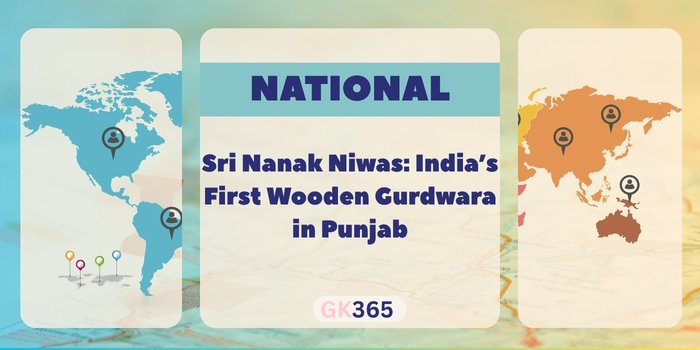Introduction
India has built its first wooden Gurdwara, Sri Nanak Niwas, in Fazilka, Punjab. Made entirely of Finnish Deodhar wood, the shrine sits inside the Fazilka police lines. It serves as both a space for worship and a model of sustainable design.
Driven by the vision of SSP Bhupinder Singh Sidhu, the structure was completed in 2023. It offers daily prayers and welcomes visitors from India and abroad.
This article explains the Gurdwara’s purpose, structure, design, and growing role in Punjab’s religious life.
📚 Table of Contents
- Why Sri Nanak Niwas Is in the News
- Vision Behind the Wooden Gurdwara
- Key Architectural Features
- Construction & Design Details
- Community Role and Religious Activities
- Significance and Symbolism
- Boost to Religious Tourism in Punjab
- Sustainability in Sacred Architecture
- FAQs
- Related Articles & Resources
- Conclusion
- Key Takeaways Table
🔹 Why Sri Nanak Niwas Is in the News
Sri Nanak Niwas has become known across India as the country’s first wooden Sikh shrine. Built entirely from Finnish Deodhar wood, it brings together faith and sustainability. Its location in the police quarters adds to its unique presence.
SSP Bhupinder Singh Sidhu led the project. His effort turned a personal idea into a shared space for devotion and public gathering.
🔹 Vision Behind the Wooden Gurdwara
Three goals shaped the creation of Sri Nanak Niwas:
- A Place for Worship: To offer a prayer space for police staff and families.
- Design with Meaning: To reflect Sikh ideas of service and openness through four accessible doors.
- A New Approach: To merge tradition with strong, modern wooden construction.
The result honors Guru Nanak’s teachings with a structure built for today.
🔹 Key Architectural Features
- Made entirely of Finnish Deodhar wood, known for its durability.
- 40 feet on each side with four doors symbolizing Sikh inclusiveness.
- Completed in just three months and inaugurated on February 16, 2023.
- Woodwork led by carpenter Iqbal Singh from Ludhiana.
🔹 Construction & Design Details
- Transport: Wood was shipped from Finland and brought to Fazilka by road.
- Structure: Beam alignment ensured balance and clean lines.
- Airflow: Domes and arches allow natural ventilation.
- Orientation: Doors face north and south to block seasonal winds.
The project mixes sacred design with solid, practical methods.
🔹 Community Role and Religious Activities
Sri Nanak Niwas is a space for both prayer and public life:
- Daily Prayers: The Guru Granth Sahib is placed at 5:30 a.m. and closed at 8 p.m.
- Ceremonies: Regular recitations and weddings take place.
- Sunday Gatherings: Weekly Sangat sessions draw large groups.
The Gurdwara committee keeps things organized and open to all.
🔹 Significance and Symbolism
- Service-Led Leadership: A police officer’s faith created a lasting place of worship.
- New Ideas with Old Roots: Wooden building methods blend with Sikh tradition.
- State Symbol: The site enhances Punjab’s religious and cultural identity.
Sri Nanak Niwas proves that faith-led public work can be inclusive and lasting.
🔹 Boost to Religious Tourism in Punjab
- Unique Design: India’s only wooden Gurdwara attracts tourists and design lovers.
- Spiritual Setting: Devotees visit for prayer and reflection.
- Local Benefits: Increases footfall for businesses and workers in the region.
Tourism boards and Sikh groups are expected to include it in future tours and media.
🔹 Sustainability in Sacred Architecture
- Material Choice: Finnish wood is durable and eco-friendly.
- Cooling Design: Architecture supports natural ventilation, reducing energy use.
- Low Waste: Local workers minimized material waste during construction.
The shrine combines spiritual purpose with climate-conscious design.
❓ FAQs: Sri Nanak Niwas – India’s First Wooden Gurdwara
- What makes this Gurdwara special?
It is India’s first wooden Sikh shrine, built from Finnish Deodhar wood using Sikh values of equality and openness. - Who led the project?
SSP Bhupinder Singh Sidhu led the project inside Fazilka’s police campus. - Why use Finnish wood?
This wood lasts long, resists pests and weather, and is environmentally responsible. - Can tourists visit?
Yes, it is open to both domestic and international visitors. - How does it help the local area?
It brings people together, supports small businesses, and adds to local pride.
🔗 Related Articles & Resources
📢 Conclusion
Sri Nanak Niwas shows how faith, design, and public service can work together. With the effort of Bhupinder Singh Sidhu and the skill of Iqbal Singh, the Gurdwara stands as a model of worship and care for the environment.
As public buildings evolve, this Gurdwara shows one way forward — where spiritual life meets modern needs.
👉 Want more stories like this?
Visit GK365.in to learn about sacred sites and heritage stories across India.
Key Takeaways Table
| Category | Details |
|---|---|
| Monument Name | Sri Nanak Niwas – India’s first wooden Gurdwara |
| Location | Fazilka, Punjab, within the Fazilka police lines |
| Material Used | Constructed entirely from Finnish Deodhar wood – durable and eco-friendly |
| Inauguration Date | February 16, 2023 |
| Project Lead | SSP Bhupinder Singh Sidhu, Fazilka |
| Architectural Features | – 40 ft. square design with 4 doors (symbolizing Sikh openness)- Domes and arches for natural ventilation- Doors face N & S for airflow |
| Construction Details | – Completed in just 3 months– Wood imported from Finland- Designed and crafted by carpenter Iqbal Singh from Ludhiana |
| Purpose & Vision | A place of worship for police families, designed to reflect Sikh values of inclusiveness and humility with modern sustainable architecture |
| Daily Use & Activities | – Daily recitations (5:30 AM to 8 PM)- Sunday Sangat gatherings- Ceremonies including weddings and kirtans |
| Community & Cultural Role | Enhances Punjab’s religious and architectural heritage; promotes interfaith unity, design innovation, and sustainability |
| Tourism & Impact | Draws both spiritual pilgrims and design enthusiasts; expected to boost religious tourism and local economy |
| Environmental Focus | – Wooden architecture for reduced energy use- Natural cooling and ventilation- Low material waste during construction |



